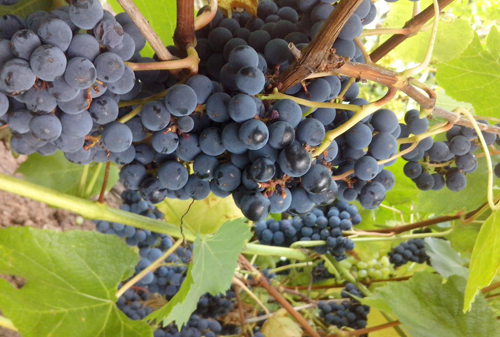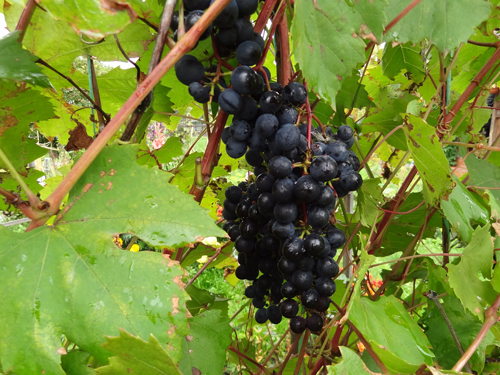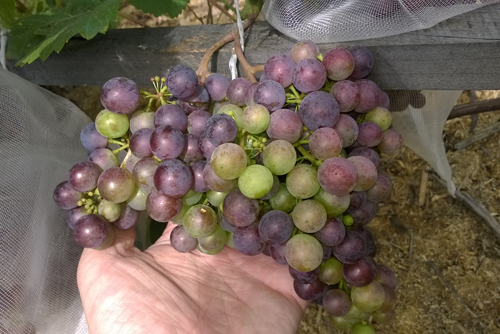Grape variety Sharov's Riddle
The cultivation of grapes, a traditionally southern plant, in the northern regions, and even more so in Siberia, for a long time remained the dream of scientists, enthusiastic researchers, and simply exotic lovers in their summer cottages and backyards. One of these dreamers was Rostislav Sharov from the city of Biysk, Altai Territory. But Rostislav Fedorovich not only dreamed, but devoted his whole life to the popularization of Siberian viticulture. A veteran of the Great Patriotic War, an engineer by training, since the 60s of the last century, he began cultivating, testing varieties, honing the technology of cultivating solar berries in Siberia, and then his own research in the field of grape plant breeding and the creation of new hybrids adapted to the harsh local climate. In his homeland he is called the number one Siberian Winegrower, and Biysk, of which Rostislav Fedorovich became an honorary resident in 2007, thanks to his selfless work won fame as a city of winegrowers. On Sharov's initiative, the Biysk Center for Siberian Viticulture was created, which to this day is actively engaged in research, scientific, educational and educational activities, actively expanding the circle of local viticulture lovers.

During his long and fruitful life, Rostislav Sharov tried many hundreds of European, Amur and American grape varieties, a significant part of which he acclimatized for cultivation in Altai. But this was not enough for him, and therefore he spent a significant part of his ebullient energy on creating his own hybrids. As a folk breeder, he created more than twenty promising forms of the vine, adapted to local cultivation conditions, and at the same time possessing a sufficiently high quality of fruit. One of the first such novelties is the Sharov's Riddle, developed back in 1972 and has since become widespread among amateur winegrowers in many regions of Siberia, the Urals and the north of the European part of the country. It was obtained from pollination of the Far Eastern variety Lapchaty with a mixture of pollen of early varieties, such as Magarach No. 352, Tukai and a number of others. The result is a very frost-resistant, early-ripening, rather unpretentious grape, quite suitable for table use, although it does not reach the high-quality southern varieties in terms of large-fruited and visual appeal.
Agrobiological characteristics
Sharov's riddle is distinguished by good vigor, considerable length and moderate thickness of annual vines. The crown of a young shoot is yellowish-green with a distinct bronze tint, shiny, without pubescence. Leaves are medium in size, somewhat stretched in width, cordate, have five lobes and a medium degree of dissection. The upper side of the leaf blade is reticulate-wrinkled, bright green, on the lower one there is no pubescence. The upper lateral notches are deep, open, lyre-shaped, usually with a sharp bottom, the lower ones are less deep, V-shaped. The petiole is wide, open, with a flat bottom. Petioles are of medium length, reddish-green in color. The teeth along the edge of the leaf are triangular, with a wide base, convex edges and sharp tops. Grape flowers are bisexual, do not require the presence of additional pollinators. Berries are not prone to peas. Shoots ripen well early. Internodes on annual vines are short, eyes are relatively large.
The bunches of the variety are medium in size, branched or winged in shape, and loose in density. The average mass of mature brushes of Sharov's Riddle is 100-200 grams, the maximum reaches 500 grams. The crest is fragile, branched, light green in color. The comb is quite long and strong, sometimes even lignified at the point where it adjoins the shoot.The berries are freely arranged in a bunch, they are not damaged or deformed against each other. The grapes are round, medium-sized, fairly even in size. The diameter of the berries is about 2 cm, the weight of 100 pieces ranges from 220 to 300 grams. The pulp is juicy and very tender, literally melting in your mouth. The taste is pleasant, harmonious, with the manifestation of a varied bouquet of aromas, alternating in the process of ripening, but with a predominance of strawberry shades. The sugar content of berry juice reaches high values - 21-22 grams / 100 ml, the acidity is quite low - 4-5 grams / liter. The skin is thin, but quite firm, and relatively easy to chew when eaten. The color of the skin is dark blue, the surface is covered with an intense protective waxy coating of a bluish tint. There are 2-3 seeds in the berry, they are medium in size, but nevertheless, they are felt quite strongly during tasting. Gastronomic assessments of fresh grapes are satisfactory, but taking into account the ability of Sharov's Riddle to grow where few southern varieties are able to survive, a comparison of their taste qualities seems to be not entirely correct.

Harvest of universal use. Our hero looks equally dignified both when consumed fresh and processed into delicious and aromatic juices and compotes. In addition, due to its good sugar accumulation, it can be used in home winemaking. Drinks from it are quite saturated in color, however, due to the thin skin, they are low-tannic and short-lived. A rather low acidity does not add expressiveness to wines, it can also cause the development of such a defect as oxidase cass (browning of wine) during prolonged contact of the drink with atmospheric oxygen, for example, in incomplete containers. All this speaks of the need to consume wine from this variety in a young form without much hope of improving its characteristics with long aging. To prevent the loss of pigmentation of the drink from Sharov's Riddle, reduce its taste and acquire a specific taste of boil-over, it is recommended that the first pouring (removal from the sediment) be made with minimal contact with air, and the pouring itself should be carried out in small containers in order to consume wine in a short time after opening each of them. Fresh grapes are well transported and stored without reducing its quality. In cool, dry rooms, the bunches can remain edible for 2 to 3 months.
The harvest ripens very early, in its homeland, Biysk, it ripens already in August. With the growing season from bud break up to the onset of technical ripeness, equal to 100-110 days, Sharov's Riddle needs a very modest sum of active temperatures - 2000-2100 ° C. These characteristics are quite suitable for cultivating it in northern latitudes, which are not distinguished by long, excessively hot summers. This is also facilitated by the very high frost resistance of the vine (-32 ° C). Thanks to her, the variety can be cultivated in the middle zone of the European part of the country without shelter for the winter, however, in the north, and even more so in Siberia, a laborious procedure for protecting bushes from the winter cold is still necessary.
The productivity of the grapes cannot be called outstanding. Despite the very abundant flowering and the setting of numerous clusters, the plants are not able to "pull" too abundant harvests, reacting to overload by reducing the average weight of the bunches, their loosening and a decrease in the overall quality of the collected fruits. The yield standard for Sharov's Riddle should be taken as an indicator of 5-8 kilograms per bush. This may seem quite modest, especially given the ability of plants to plant 2-3 bunches on each shoot, however, if we talk about the desire to get high-quality grapes, it is worth focusing on this figure and, in accordance with it, regulate the load on the bush of this variety.

After ripening, the bunches can hang on the bushes for as long as the conditions of the short northern summer can allow. This grape variety does not have an obvious predisposition to cracking and decay of berries.Wasps also do not cause significant damage to a ripe crop, but birds that are not averse to eating sweet berries can cause troubles.
Agrotechnical features
Due to the high unpretentiousness of the variety, there should not be significant difficulties for a winegrower, even a beginner, with the cultivation of Sharov's Riddle. But, nevertheless, it will not be superfluous to know about a number of specific properties in his agricultural technology.
Our hero does not make special demands on soils, being able to grow even on the poorest of them, but he responds well to fertilization and regular feeding. Planting is carried out by cuttings, which are quite simple to prepare and root, which greatly facilitates its reproduction. There is no need to inoculate seedlings, moreover, due to the high frost resistance of the root system, Sharov's Riddle is capable of itself serving as a winter-hardy stock for more pampered varieties of grapes.
Bushes are formed taking into account plans to shelter them for the winter. In Siberian conditions, as a rule, a multi-arm fan formation is used with a short pruning of fruit arrows for 2-3 eyes, which are quite enough to obtain a full-fledged harvest, due to the good productivity of even the lowest buds. This property of the variety greatly facilitates the autumn insulation of compact sleeves, for which the available organic heat-insulating materials are used: spruce branches, straw, reeds or sawdust. On top of such a shelter, it is necessary to provide a waterproofing layer of roofing material, film or wooden shields, to prevent the vine from getting wet and the eyes on it to dry out. In those regions of the middle zone, where the frost resistance of plants allows them to be grown in a non-covering culture without the risk of freezing of the aboveground part in winter, standard formations can be used, also shortly cutting off fruit arrows.
The variety begins to bear fruit quite early, and already in the second year you can leave a couple of "signal" bunches on a young bush to try the first harvest in the summer. In the future, every year, as the grape bushes grow, the load is increased with a full-fledged yield by the fourth or fifth year. The overload-prone Sharov Riddle requires careful annual normalization. With spring pruning, the load on an adult bush is given in the range of 25-30 eyes. During the debris during green operations, the strongest ones, up to 12 in number, are left from the developed shoots, removing the weak and sterile ones. And, finally, on fertile vines, pluck out excess inflorescences, keeping one or two per shoot, depending on the energy of its growth.
In terms of disease resistance, the variety deserves a good characterization. Resistance to powdery mildew and gray rot in Sharov's Riddle is quite high, and only mildew is affected in an average degree. In this regard, it can be recommended to carry out two sprays to combat downy mildew before and after the flowering of grapes, as well as complex treatment against downy mildew and powdery mildew at the stage of berry growth. The adoption of chemical measures to protect plants from pests is justified only in the event of their mass spread, which does not happen often.
Summing up, we can say that Sharov's Riddle is a very worthy form for northern, and even more so Siberian, viticulture. Despite its venerable age, it is still widespread among amateurs, and thanks to a whole range of positive qualities, it is loved and respected by them.








